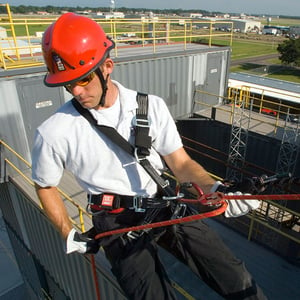How often should I replace my rescue harness?

We get many calls asking about the “life expectancy” of rope, harnesses and other nylon products. Of course, there are many factors involved and no one “set in stone” answer, but a lot depends on how much you use your harness and the ways you use it. Even where you store your gear is a factor.
For example, for emergency responders working in industrial environments, atmospheric exposures may be a key consideration for nylon products even while in storage. Another consideration is “when” the harness or rope was made… manufacturing parameters change as technology improves and you may just want a product that’s been tested to the latest standards. However, as with all of your rescue equipment, it’s important to account for its use as well as to follow the manufacturer’s instructions.
Never take chances when there’s any doubt about the serviceability of a life safety product. For more details on the service life of nylon products, our harness manufacturer, CMC Rescue, has provided the following information:
The service life of a rescue harness is closely related to the life of a rescue rope – both are used in the same environments, both are made from nylon or polyester, and both receive similar levels of inspection and care. Since harnesses are worn on the body, they are generally better protected than the ropes. On the other hand, harnesses rely on the stitching to hold them together, and due to its small diameter, the thread can be more susceptible to abrasion, aging, and chemical damage than web or rope.
The fall protection industry recommends 2 to 3 years as a service life for a harness or belt in use. They recommend 7 years for the shelf life. The military was using 7 years as a service life for nylon products. The Climbing Sports Group of the Outdoor Recreation Coalition of America says that a climbing harness should last about two years under normal weekend use. At this time, the rescue industry does not have a recommended service life for harnesses.
Through the ASTM consensus standards process, the rescue industry set 10 years as the maximum service life for a life safety rope, see ASTM Standard F1740-02 Guide for Inspection of Nylon, Polyester, or Nylon/Polyester Blend, or both Kernmantle Rope. The guide stresses that the most significant contributing factor to the service life of a rope is the history of use. A rope that is shock loaded or otherwise damaged should be retired immediately. Hard use would call for a shorter service life than would be acceptable for a rope that sees very little use.
If we apply the same analysis to the rescue harness, then the actual use and the conclusions drawn from inspection would be the significant criteria for retirement. We do know that with any use, a rope will age, and thus a harness is likely to do the same, so a 10-year maximum service life may well be appropriate for harnesses as well assuming inspection has not provided any reason for early retirement.
As with ropes, if the harness has been subjected to shock loads, fall loads, or abuse other than normal use, the harness should be removed from service. If there is any doubt about the serviceability of the harness for any reason, it should be removed from service.
Additional Resources

Quick-Connect Harness Buckle Safety
Service Life Guidelines for Rescue Equipment
Guidelines for Permanent Marking of Rescue Hardware




